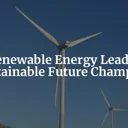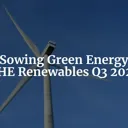Tags: BHE / ESG
This fanpage is not officially affiliated with Berkshire Hathaway: Disclaimer

Introduction
Berkshire Hathaway Energy (BHE) is an almost full subsidiary of Berkshire Hathaway. BHE has been at the forefront of the green energy transition in the United States. The company, through its various subsidiaries, has successfully diversified its operations across the energy landscape, including renewable energy generation, natural gas distribution, and electric utility services. With the global demand for clean and sustainable energy sources growing rapidly, BHE's commitment to investing in renewable energy and related technologies has positioned the company as a key player in the industry.
The green energy transition in the United States has gained significant momentum in recent years, with governmental policies, technological advancements, and changing consumer preferences driving a shift toward sustainable energy solutions. As a shareholder in BHE, it is crucial to understand the company's strategic investments and initiatives in this evolving landscape.
This article will provide insights into BHE's efforts in renewable energy, energy storage technology, energy efficiency initiatives, electric vehicle infrastructure, and partnerships with local communities, highlighting the potential benefits of these endeavors and their impact on long-term shareholder value.
Let us look into the 5 ways why Berkshire Hathaway will lead the green energy transition in the United States. We will specifically have a look how shareholder value can be positively affected by the transition. Because, and that's very important, the transition might only be sustainable if people can make a living with it after all. The main sources of the article can be found / linked on Berkshire Hathaway Energy's about page.
1 Investment in renewable energy
Berkshire Hathaway Energy's commitment to renewable energy is evident in its robust portfolio of clean energy projects. The company has consistently invested in the development of wind and solar power generation facilities across the United States, aligning itself with the nation's goal of achieving a more sustainable and environmentally friendly energy mix ↗.
Significant investments in solar and wind projects include the Solar Star project, one of the largest photovoltaic solar plants in the nation, and the Alta Wind Energy Center, which is among the largest onshore wind farms in the world. These projects not only contribute to the nation's green energy transition but also demonstrate BHE's dedication to maintaining a leadership position in the renewable energy sector.
The potential benefits of investing in renewable energy are multifold. As the cost of renewable energy technologies continues to decrease, the competitiveness of these energy sources increases. This trend is expected to lead to greater demand for clean energy, providing BHE with ample growth opportunities. Additionally, as governments worldwide implement policies to curb greenhouse gas emissions, companies with a strong renewable energy portfolio are poised to benefit from incentives and regulatory support.
Impact on shareholder value and long-term growth
By investing in renewable energy, BHE is positioning itself to capitalize on the expanding clean energy market, which is expected to drive revenue growth and strengthen the company's competitive advantage. As a result, shareholders stand to benefit from the potential increase in value and profitability stemming from BHE's commitment to a sustainable energy future ↗. Furthermore, by embracing renewable energy, the company mitigates risks associated with regulatory changes and potential carbon pricing, ensuring long-term stability for investors.
Please also have a look at Warren Buffett discussing the phase-in of renewables by Berkshire Hathaway and the challenges faced (shareholder meeting 2023):
2 Energy storage technology
The importance of energy storage technology in the green energy transition cannot be overstated. Energy storage systems, such as batteries, play a critical role in addressing the intermittency of renewable energy sources like solar and wind power. By investing in energy storage technology, BHE is working to create a more resilient and reliable energy infrastructure for the future ↗.
Berkshire Hathaway Energy's investment in energy storage technology includes projects like the 1,200-megawatt Moss Landing energy storage facility in California. This massive project, which uses lithium-ion battery technology, demonstrates the company's commitment to integrating cutting-edge energy storage solutions into its operations. By supporting the development and deployment of advanced energy storage systems, BHE is helping to enable the large-scale integration of renewable energy into the power grid.
Potential benefits of energy storage technology include improved grid reliability, reduced dependence on fossil fuels, and greater flexibility in managing energy supply and demand. Energy storage systems also provide opportunities for new revenue streams, such as grid services and demand response programs.
Enhancing shareholder value through energy storage investments
Investments in energy storage technology are expected to enhance shareholder value in several ways. Firstly, by addressing the intermittency of renewable energy sources, BHE is better positioned to maximize the return on its renewable energy investments. Secondly, energy storage systems can help the company capitalize on new revenue opportunities and cost savings, which may contribute to increased profitability. Finally, by investing in innovative energy storage technologies, BHE demonstrates its commitment to staying ahead of industry trends and maintaining a competitive edge, thereby securing long-term value for its shareholders.
3 Energy efficiency initiatives
Berkshire Hathaway Energy's focus on energy efficiency initiatives reflects its commitment to reducing energy consumption and promoting sustainable practices across its operations. These initiatives not only help lower greenhouse gas emissions but also result in cost savings for the company and its customers.
Examples of energy efficiency initiatives undertaken by BHE and its subsidiaries include the installation of energy-efficient lighting, HVAC system upgrades, and the implementation of demand-side management programs. These programs encourage customers to adopt energy-saving measures, such as using smart thermostats, upgrading insulation, and optimizing energy usage during periods of peak demand.
Potential benefits of energy efficiency initiatives are substantial. By reducing energy consumption, BHE can lower its operational costs, improve system reliability, and decrease its environmental footprint. Moreover, energy efficiency measures can lead to customer satisfaction, as they can help customers save on their energy bills while contributing to a more sustainable future.
Contribution to shareholder value through energy efficiency initiatives
BHE's focus on energy efficiency initiatives can have a positive impact on shareholder value in several ways. Cost savings resulting from reduced energy consumption can lead to increased profitability and, ultimately, higher returns for shareholders. Furthermore, energy efficiency initiatives can help the company maintain a positive public image and strengthen customer loyalty, both of which are important factors in ensuring long-term business success. Lastly, by prioritizing energy efficiency, BHE demonstrates its proactive approach to addressing potential regulatory changes related to energy consumption and emissions, thereby mitigating risks for investors.
4 Electric vehicle infrastructure
As the electric vehicle (EV) market continues to grow, the demand for reliable and accessible charging infrastructure is becoming increasingly critical. Berkshire Hathaway Energy recognizes this emerging need and has been actively investing in electric vehicle infrastructure to support the transition to clean transportation.
Berkshire Hathaway Energy's investment in electric vehicle infrastructure includes the development of charging stations and the integration of EV-related technologies into the power grid. By expanding the availability of charging solutions, BHE is facilitating the adoption of electric vehicles, which can help reduce greenhouse gas emissions and contribute to a more sustainable transportation system.
Potential benefits of electric vehicle infrastructure investments include improved air quality, reduced reliance on fossil fuels, and the opportunity to capitalize on the growing EV market. By supporting the expansion of EV infrastructure, BHE is positioning itself as a key player in the clean transportation sector, which is expected to experience significant growth in the coming years.
Impact on shareholder value and competitive advantage
Investing in electric vehicle infrastructure can have a positive impact on shareholder value by opening up new revenue streams and growth opportunities for BHE. As the EV market expands, the company's investments in charging infrastructure can provide a competitive advantage and help secure a foothold in this burgeoning sector. Additionally, BHE's commitment to clean transportation aligns with global efforts to mitigate climate change, which can further enhance its reputation and strengthen its relationship with regulators and customers. This, in turn, can contribute to long-term shareholder value and business stability.
5 Partnerships with local communities
Berkshire Hathaway Energy's partnerships with local communities are a vital aspect of its business strategy. These partnerships enable the company to better understand the needs and concerns of the communities it serves, ensuring that its projects are developed in a manner that benefits all stakeholders.
Examples of successful partnerships include BHE's collaboration with local governments, educational institutions, and non-profit organizations to promote energy efficiency and renewable energy initiatives. These partnerships often involve providing grants, resources, and expertise to support community-driven projects, such as energy-efficient building retrofits, solar panel installations, and educational programs focused on sustainability.
Potential benefits of partnerships with local communities include fostering goodwill and trust among stakeholders, promoting a more sustainable and resilient energy infrastructure, and creating new opportunities for economic growth and job creation. By engaging with communities and working collaboratively on energy-related projects, BHE can support local development while reinforcing its commitment to environmental stewardship.
Strengthening shareholder value through community partnerships
Forming strong partnerships with local communities can contribute to shareholder value in several ways. By building and maintaining positive relationships with stakeholders, BHE can mitigate potential risks associated with project development, such as delays and opposition from community members. This can lead to smoother project execution, cost savings, and more predictable returns on investment. Additionally, community partnerships can enhance BHE's reputation as a socially responsible company, which can help attract and retain customers and investors who prioritize environmental, social, and governance (ESG) factors. By fostering these partnerships, BHE demonstrates its dedication to creating shared value for both its shareholders and the communities it serves.

Conclusion
Berkshire Hathaway Energy's efforts to lead the green energy transition in the United States are evident in its strategic investments and initiatives across renewable energy, energy storage technology, energy efficiency, electric vehicle infrastructure, and partnerships with local communities. These endeavors not only contribute to a more sustainable and resilient energy landscape but also have the potential to create significant value for shareholders.
By embracing the green energy transition, BHE is well-positioned to capitalize on emerging opportunities in the clean energy market and secure long-term growth. The company's focus on innovative technologies and solutions demonstrates its commitment to staying ahead of industry trends and maintaining a competitive edge. Furthermore, BHE's proactive approach to addressing environmental challenges and fostering strong community partnerships underscores its dedication to creating shared value for both its shareholders and the communities it serves.
As the world continues to grapple with the impacts of climate change and the urgent need for sustainable energy solutions, Berkshire Hathaway Energy's leadership in the green energy transition stands as a testament to its vision, resilience, and commitment to delivering long-term value for its shareholders and a brighter future for generations to come.
PS.: Some remarks on Berkshire's investments in oil companies vs. the green energy transition
Berkshire Hathaway's investment in Occidental Petroleum and other oil companies may seem, at first glance, to contradict the green energy transition of Berkshire Hathaway Energy. However, it is important to consider a few factors that demonstrate how these investments do not necessarily undermine BHE's commitment to clean energy.
- Diversification: As a multinational conglomerate, Berkshire Hathaway seeks to diversify its investments across various industries and sectors. Investing in both renewable energy and traditional energy sources allows the company to spread risk, maintain financial stability, and capitalize on various market opportunities. This diversified approach ensures that the company remains resilient in the face of changing market conditions, ultimately benefiting BHE and its shareholders.
- Responsible transition: The global transition to renewable energy will not happen overnight, and traditional energy sources will continue to play a significant role in meeting energy demands in the short to medium term. By investing in oil companies such as Occidental Petroleum, Berkshire Hathaway can support responsible and efficient operations within the industry, ensuring that the transition to green energy is as smooth and sustainable as possible.
- Influence and engagement: Berkshire Hathaway's investments in oil companies provide the conglomerate with opportunities to engage with these businesses and encourage the adoption of environmentally friendly practices. Through active involvement and dialogue, Berkshire Hathaway can help drive change within the industry, pushing for improvements in efficiency, emissions reductions, and investments in clean energy technologies.
- Capital allocation for green investments: Profits generated from investments in traditional energy companies can be used to fund BHE's green energy initiatives, accelerating the development and deployment of renewable energy projects. In this way, returns from these investments can be channeled into BHE's commitment to a sustainable energy future.
In summary, Berkshire Hathaway's investments in Occidental Petroleum and other oil companies do not necessarily contradict BHE's green energy transition. Instead, they can be seen as part of a diversified investment strategy that enables the company to remain financially stable, support responsible industry practices, and ultimately drive the broader transition to clean energy.
Appendix: BHE Net Earnings Table as of end 2022
As said, the green energy transition is a very important aspect of humanity. However, it will not happen if the players are not profitable. So how does it look like, what are the earnings of BHE, a pioneer in the green energy transition?
Very simple, BHE is an earnings powerhouse. The following earnings are in million dollars:
| 2022 | 2021 | 2020 | 2019 | 2018 | |
|---|---|---|---|---|---|
| Revenues: | |||||
| Energy operating revenue | $18,935 | $21,069 | $15,556 | $15,371 | $15,573 |
| Real estate operating revenue | 5,268 | 6,215 | 5,396 | 4,473 | 4,214 |
| Other income (loss) | 56 | (54) | 79 | 270 | 200 |
| Total revenue | 26,393 | 25,096 | 21,031 | 20,114 | 19,987 |
| Costs and expense: | |||||
| Energy cost of sales | 6,757 | 5,504 | 4,187 | 4,586 | 4,769 |
| Energy operating expense | 9,233 | 8,535 | 7,539 | 6,824 | 6,969 |
| Real estate operating costs and expense | 5,117 | 5,710 | 4,885 | 4,251 | 4,000 |
| Interest expense | 2,140 | 2,054 | 1,941 | 1,835 | 1,777 |
| Total costs and expense | 23,247 | 21,803 | 18,552 | 17,496 | 17,515 |
| Pre-tax earnings | 3,146 | 3,293 | 2,479 | 2,618 | 2,472 |
| Income tax expense (benefit)* | (1,629) | (1,153) | (1,010) | (526) | (452) |
| Net earnings after income taxes | 4,775 | 4,446 | 3,489 | 3,144 | 2,924 |
| Noncontrolling interests of BHE subsidiaries | 423 | 399 | 71 | 18 | 23 |
| Net earnings attributable to BHE | 4,352 | 4,047 | 3,418 | 3,126 | 2,901 |
| Noncontrolling interests and preferred stock dividends | 448 | 475 | 327 | 286 | 280 |
| Net earnings attributable to Berkshire Hathaway shareholders | $3,904 | $3,572 | $3,091 | $2,840 | $2,621 |











